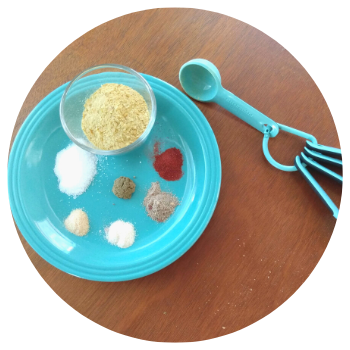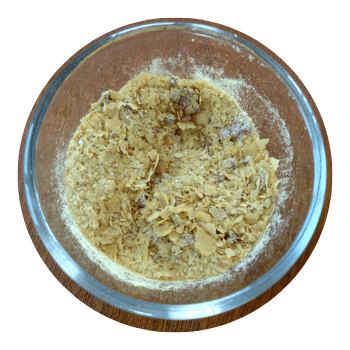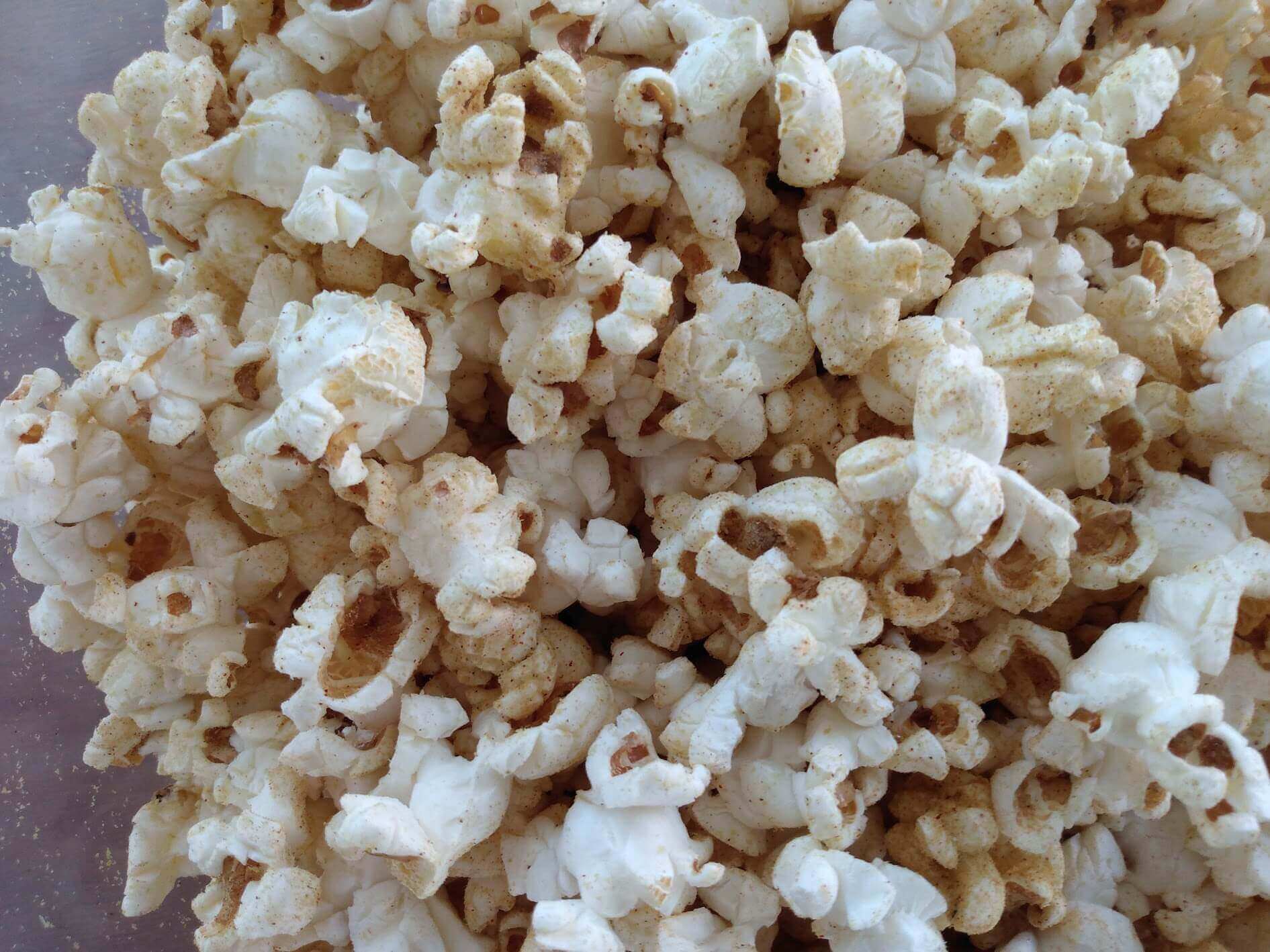When it comes to fun and healthy snacks, popcorn ranks right up there. Of course, popcorn can also be a junk food (think Cracker Jacks, Fiddle Faddle, and other sugary popcorn treats) but we’ll stay on the healthy side of the road with this popcorn seasoning recipe. In fact, this Canna-Nooch popcorn topping is an awesomely delicious vegan treat with extra kick and flavor, thanks to a mixture of kief, spices, and nutritional yeast.
For the uninitiated, nutritional yeast is a food supplement popular with vegans as well as those suffering from food allergies. This dairy-free (and often gluten-free) food product is used as a vegan cheese supplement and a topping for salads and soups. It is also a major ingredient in our very own Canna-Nooch popcorn seasoning recipe. (“Nooch” is a clever and common nickname for nutritional yeast.)
Of course, we’re pretty certain you know what “Canna” implies! If you think we mean cannabinoids, you aren’t wrong. Moreover, we are pretty sure you will be quite pleased once you throw together this fun, easy, and happiness-inducing treat!
Quick Nav: Popcorn Origins – Zea Mays Everta – Popcorn Cooking Methods – Canna-Nooch Popcorn Seasoning Recipe
Popcorn Origins
Food historians (yes, there are such people) agree that popcorn originated in the North and South American continents. Corn itself was domesticated about 10,000 years ago in Mexico. It didn’t take popcorn much longer to appear on the scene; early fossil evidence indicates that popcorn may have begun popping as early as 4700 BC (almost 7000 years ago).
And talk about shelf life… in a tomb in Peru, researchers uncovered grains of popcorn estimated to be 1,000 years old. These grains were so well preserved they can still pop!
In another unrelated but equally remarkable discovery, a popped kernel of popcorn was found in a dry cave in Utah. Big deal, you might think. Well, when you learn that this popped kernel was estimated to be 1,000 years old, you may agree it is a big deal!
For many indigenous tribes in the Americas, popcorn was more than a food. Many ceremonial dances and events used popcorn as decorations; often they became an intrinsic part of ceremonial costumes.
As with many natural gifts and wonders revealed by indigenous tribes to settlers of the “New World,” popcorn was quickly embraced by the invading Europeans. It became a popular breakfast staple for many Americans in the 1800s, with milk and sugar added. Those sweet-toothed settlers also learned that adding molasses to popcorn created a treat quite similar to the kettle corn we enjoy today!
Another advantage that popcorn offers is affordability. It is truly an inexpensive treat that is easy to prepare and fun to munch! In fact, during the Great Depression of the 1930s, popcorn was one food almost anyone could afford. And then when World War II demanded rationing by American households, which severely reduced the availability of sugar and other staples, once more popcorn came to the rescue.
With the advent of television, movie theaters suffered as did popcorn sales. But when microwave popcorn was invented in 1981, popcorn consumption once more skyrocketed. (Most microwaves even have a “Popcorn” button… now that’s popular!) You could certainly say that popcorn is now here to stay. Based on average sales from 2016 to 2020, Americans consume about 14 billion quarts of popcorn each year – about 43 quarts of popcorn per person!
Yes, we love our popcorn!
Quick Nav: Popcorn Origins – Zea Mays Everta – Popcorn Cooking Methods – Canna-Nooch Popcorn Seasoning Recipe
Meet Zea Mays Everta
Zea Mays Everta may sound like the name of an exotic singer or dancer but it is something sexier than that… It is the scientific name for popcorn!
If you want to impress anyone fascinated by popcorn, you can casually toss off the fact that the scientific name for corn is Zea mays. To further awe (or annoy) your audience, you can follow that up with: “Of course, if we are speaking of the cultivated strain of corn that pops, the correct scientific nomenclature would be ‘Zea mays everta’ as you probably know.” (If you wear glasses, the effect is more impressive if you slide those glasses to the tip of your nose and look over the top of them while making these factual pronouncements. As you know, it’s all in the presentation, so play that popcorn aficionado role to the hilt!)
Of all types of corn, popcorn is the toughest. The only way to eat it is by heating it until it bursts open. Please do not even try to eat it raw; it will most likely crack or break your teeth.
The secret to popping corn lies in the small amount of oil and water contained within the kernel. Before it’s popped, the hull is strong and impervious to moisture. Inside, along with that little bit of oil and water, is a very hard, inedible starch. It’s the magic of heat that transforms this tough, inedible seed into a fluffy culinary delight.
As the kernel is exposed to heat, the moisture from the oil and water converts into pressurized steam. This hot steam gelatinizes the starch, making it soft and pliable. Meanwhile, the heat continues building pressure until the breaking point of the hull is reached (at about 356 °F). This causes the hull to rupture and explode (POP!). That explosion releases the pressure within the kernel which then expands the softened starch (and proteins) into a fluffy foam. Once released from the heat and pressure, that foam quickly cools down. Next, the starch and protein polymers set into place, transforming it into a crispy, crunchy flake. (FYI: “Flake” is the technical term in the popcorn industry for popped corn.)
There is certainly nothing subtle or quiet about popcorn. It first makes a big pop when cooked. Next, it has an audible crunch when you eat it. It’s definitely a loud treat but so worth the noise!
The Shape of Popcorn
Few of us take the time to examine popcorn. Frankly, most people seem to fall into a trancelike state as they automatically stuff handfuls into their mouths nonstop. But to become a true popcorn aficionado you must pay attention to the finer popcorn details.
So let’s learn about popcorn shapes!
Raw popcorn comes in three shapes:
- Pearl – rounded at one end and pointed at the other end; pops into butterfly shapes
- Rice – pointed at both ends; pops into butterfly shapes
- South American – squarish shaped; pops into mushroom shapes
More about those shapes it pops into:
- Mushroom – this is a generally round shape and is popular when making sweetened popcorn as it can fully absorb the syrup or other sweetener; this shape is firmer and chewier
- Butterfly – those random and unpredictable popcorn shapes fall into this classification and are also called “snowflake” popcorn (maybe because no two shapes are alike?); this shape is more tender with fewer hulls
You are fortunate to live in these modern times, as more varieties and colors of popcorn abound. (Do remember that only the hulls are colored; most popcorn comes out in shades of white or yellow.)
Quick Nav: Popcorn Origins – Zea Mays Everta – Popcorn Cooking Methods – Canna-Nooch Popcorn Seasoning Recipe
How To Make Homemade Popcorn
When it comes to making popcorn, three popular methods come to mind: on the stove, using an air popper, or in a microwave.
Here is our opinion about each method:
- Stovetop – this classic method still does the job the best; the downsides to this traditional approach are the heat (especially during summer months!) and the hands-on attention it demands
- Air Popper – admittedly, this is better during the summertime but it still requires attention; it is also great if you want oil-free popcorn; there are two downsides to this newer technology: raw kernels can bounce out before it begins popping and the machine gets very hot and must be handled carefully
- Microwave – 👎thumbs down all around!👎 Sure, you can press the “Popcorn” button on your microwave and walk away, but have you read what’s in that bag? If you plan to eat it, our advice is do not read the ingredients beforehand! Plus you can still be burned by steam when opening the bag, so it’s an all-around bummer of a method for making healthy popcorn!
Stove Top Preparation
The beauty of the stovetop method is that any deep metal pot with a vented lid will work. Add some oil (we recommend either coconut, hemp, or olive oil) – about 2 tablespoons for a ½ cup of uncooked popcorn – and two or three kernels. Set your stove to a medium heat and wait until those kernels pop. (That’s your signal that your pot is hot enough.) Add the remaining kernels, put the lid on, and gently agitate the pot back and forth while it’s popping away.
When the popping gets less frequent (every few seconds instead of continuously), remove from the stove and place it on a hot plate. You will notice that it will still pop intermittently for a little longer. After the pops slow down to every 3 to 5 seconds, it is pretty much done. Remove the lid and pour into an attractive (or ugly, for that matter – it will be gone before you know it!) bowl.
If you want to step up your game and make the popping job easier and fun, consider getting a popcorn stovetop spinner. You can find several brands on Amazon – just search for “popcorn stovetop spinner” and you’ll get a lot of choices. We recommend you read the reviews of the one you are thinking of getting, but they all perform in a similar way. Most importantly, they work really well (no burnt kernels!) and it takes less than 5 minutes to produce a huge bowlful of popcorn!
Air Popper Preparation
This option takes about the same time as stovetop cooking but you can do it anywhere you can find a convenient plug. Obviously, a kitchen counter is a logical and natural choice.
Do have a big bowl ready to capture all those popcorn flakes. At the height of its heat frenzy, it is like a hot blizzard of flakes! As already mentioned, it’s not uncommon for a few kernels to shoot out of the air popper while the chamber is heating up; early on, they are easy to throw back but later they’re pretty hot from the constant air flow, so be careful!
If you don’t yet own an air popper, your best bet is to trot over to Amazon and search out their wide selection of models. We again recommend you read reviews but this is a pretty standard kitchen appliance so we doubt you will run into any major issues.
Microwave Preparation?
No instructions are required beyond this one recommendation… DON’T! You deserve better than microwaved popcorn!
Quick Nav: Popcorn Origins – Zea Mays Everta – Popcorn Cooking Methods – Canna-Nooch Popcorn Seasoning Recipe
Our Canna-Nooch Popcorn Seasoning Recipe!
If you like fast and loose recipes, this might be the fastest and loosest recipe you can find. Your primary ingredient is nooch (nutritional yeast), in which you combine other ingredients to your liking. However, since we are not intimately familiar with your liking we decided to go with our liking for this suggested recipe. We just hope “our liking” is to your liking! 🙂

Nooch Seasoning Ingredients
- 4 tablespoons of nutritional yeast
- 1 teaspoon of salt
- ½ teaspoon of kief
- ¼ teaspoon of garlic powder
- ¼ teaspoon of ground paprika
- ¼ teaspoon of onion powder
- ¼ teaspoon of umami powder
Directions
- We recommend that you mix your seasoning prior to cooking your popcorn. Adding it while your popcorn is still hot allows the nutritional yeast to saturate more thoroughly.
- Pop your popcorn using whichever method you prefer – stovetop or air popper.
- Once popped, pour your popcorn into a large bowl with a lid.
- Add your seasoning, snap on the lid, and give it a vigorous shaking.
- Remove the lid and voila! You just made your own Canna-Nooch Popcorn!
If you don’t have a bowl with a lid, you can stir in your mix but it can get messy. Another advantage to using a large container with a lid is that if for some reason you don’t eat all your popcorn in one sitting, it stays fresh longer when sealed.
Alternate Canna-Nooch Popcorn Seasoning Recipe Ideas
Our standard Canna-Nooch Seasoning leans to the “earthy” side, thanks to the inclusion of umami, onion, and garlic powders along with paprika. Especially since kief itself offers a nice earthy flavor, we think this seasoning mix is excellent for your Canna-Nooch Popcorn.
However, there are plenty of ways to season your popcorn! In each case, you start with the same base, as follows:
- 4 tablespoons of nutritional yeast
- 1 teaspoon of salt
- ½ teaspoon of kief
Then you add the spices you think would make this your signature recipe!
Here is a list of savory spices we like:
- Red Pepper Flakes
- Dill
- Lemon Zest
- Taco Seasoning
- Rosemary
If you like your popcorn sweet, try these…
- Brown Sugar
- Cinnamon
- Nutmeg
- Cocoa Powder
- Vanilla Powder
Seeds are also great additions to either a savory or sweet spice mix. Consider including the following for even more crunch and flavor:
- Flax Seeds
- Hemp Seeds
- Sesame Seeds
Choosing Your Cooking Oil
Cooking popcorn in certain oils can further enhance the savory or sweet effect you want to achieve. We recommend you use one of these three cooking oils for your popcorn:
- Coconut Oil – excellent for sweet spice mixes
- Hemp Oil – good for either sweet or savory spice mixes
- Olive Oil – outstanding for savory spice mixes
You can also experiment with other cooking oils. Popular cooking oils offering different flavors include:
- Avocado Oil
- Canola Oil
- Grapeseed Oil
- Peanut Oil
- Sunflower Oil
Air Poppers And Oil
The whole idea behind an air popper is to make popcorn without cooking oil. Some people like to add a little oil after. After all, it enhances flavor as it helps the spice mix cling better to the popcorn flakes.
If you want to add oil to your air-popped popcorn, use a spray bottle with a mist setting. This allows for a light and even spread of your selected oil. If your bowl has a lid, cover it and shake the popcorn to thoroughly cover it. If you don’t have a lid, carefully stir your popcorn to spread the oil.
Once the popcorn is coated with oil, sprinkle ⅓ of your Canna-Nooch seasoning over it. Skake (or stir) thoroughly and repeat twice more.
Estimating Your Canna-Nooch Popcorn Seasoning Cannabinoid Potency
Last but certainly not least, let’s get an idea of how much kief ended up in your spice mix.
Our recipe calls for the use of ½ teaspoon of kief. Let’s assume you choose a kief product with a 20% CBD potency.
- A ½ teaspoon of kief works out to between ¼ and ⅓ of a gram.
- A gram of kief contains 20% CBD; this is equal to 200mg of CBD.
- Consequently, a ½ teaspoon of kief should have between 50mg and 67mg of CBD.
If 67mg of CBD for your popcorn treat seems too much, then just use ¼ teaspoon of kief. If you want more CBD, measure out a full teaspoon of kief instead!
The Blast-Off Psychotropic Option
This recipe has focused on using CBD as your primary cannabinoid. As you already know, CBD does not contain psychotropic properties.
 There might be times when you want a little extra blast in your Canna-Nooch Popcorn. With our Micronized Delta 8, you can easily add a psychotropic bump to your seasoning!
There might be times when you want a little extra blast in your Canna-Nooch Popcorn. With our Micronized Delta 8, you can easily add a psychotropic bump to your seasoning!
For your first time, we recommend you add just ⅛ of a teaspoon of this incredibly effective powder (it mixes beautifully with salt). Remember that it absorbs better than other cannabinoids so you don’t need too much!
Here is our calculation of the potency of that tiny amount of Micronized Delta 8:
- ⅛ teaspoon of Micronized Delta 8 weighs about 0.15 grams
- A gram of Micronized Delta 8 contains 20.3% of Delta 8 THC (203mg)
- Therefore, 0.15 grams contains about 30mg
Trust us, due to the high absorption rate and fast-acting properties of our Micronized Delta 8, you will likely feel the effects from those 30 mg very quickly.
Be wary though! Combining psychotropic compounds with a funny movie could keep you giggling all night long! 😉

